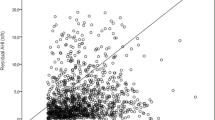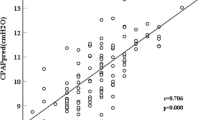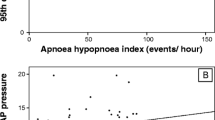Abstract
Background
Numerous mathematical formulas have been developed to determine continuous positive airway pressure (CPAP) without an in-laboratory titration study. Recent studies have shown that style of CPAP mask can affect the optimal pressure requirement. However, none of the current models take mask style into account. Therefore, the goal of this study was to develop new predictive models of CPAP that take into account the style of mask interface.
Methods
Data from 200 subjects with attended CPAP titrations during overnight polysomnograms using nasal masks and 132 subjects using oronasal masks were randomized and split into either a model development or validation group. Predictive models were then created in each model development group and the accuracy of the models was then tested in the model validation groups.
Results
The correlation between our new oronasal model and laboratory determined optimal CPAP was significant, r = 0.61, p < 0.001. Our nasal formula was also significantly related to laboratory determined optimal CPAP, r = 0.35, p < 0.001. The oronasal model created in our study significantly outperformed the original CPAP predictive model developed by Miljeteig and Hoffstein, z = 1.99, p < 0.05. The predictive performance of our new nasal model did not differ significantly from Miljeteig and Hoffstein’s original model, z = −0.16, p < 0.90. The best predictors for the nasal mask group were AHI, lowest SaO2, and neck size, whereas the top predictors in the oronasal group were AHI and lowest SaO2.
Conclusion
Our data show that predictive models of CPAP that take into account mask style can significantly improve the formula’s accuracy. Most of the past models likely focused on model development with nasal masks (mask style used for model development was not typically reported in previous investigations) and are not well suited for patients using an oronasal interface. Our new oronasal CPAP prediction equation produced significantly improved performance compared to the well-known Miljeteig and Hoffstein formula in patients titrated on CPAP with an oronasal mask and was also significantly related to laboratory determined optimal CPAP.


Similar content being viewed by others
References
Kushida CA, Littner MR, Hirshkowitz M, Morgenthaler TI, Alessi CA, Bailey D, Boehlecke B, Brown TM, Coleman J Jr, Friedman L, Kapen S, Kapur VK, Kramer M, Lee-Chiong T, Owens J, Pancer JP, Swick TJ, Wise MS (2006) Practice parameters for the use of continuous and bilevel positive airway pressure devices to treat adult patients with sleep-related breathing disorders. Sleep 29(3):375–380
Javaheri S, Parker TJ, Liming JD, Corbett WS, Nishiyama H, Wexler L, Roselle GA (1998) Sleep apnea in 81 ambulatory male patients with stable heart failure. Types and their prevalences, consequences, and presentations. Circulation 97(21):2154–2159
Sin DD, Fitzgerald F, Parker JD, Newton G, Floras JS, Bradley TD (1999) Risk factors for central and obstructive sleep apnea in 450 men and women with congestive heart failure. Am J Respir Crit Care Med 160(4):1101–1106. doi:10.1164/ajrccm.160.4.9903020
Sanner BM, Konermann M, Sturm A, Muller HJ, Zidek W (1997) Right ventricular dysfunction in patients with obstructive sleep apnoea syndrome. Eur Respir J 10(9):2079–2083
Yaggi HK, Concato J, Kernan WN, Lichtman JH, Brass LM, Mohsenin V (2005) Obstructive sleep apnea as a risk factor for stroke and death. N Engl J Med 353(19):2034–2041. doi:10.1056/NEJMoa043104
Thorpy M (2006) Obstructive sleep apnea syndrome is a risk factor for stroke. Curr Neurol Neurosci Rep 6(2):147–148
Kessler R, Chaouat A, Weitzenblum E, Oswald M, Ehrhart M, Apprill M, Krieger J (1996) Pulmonary hypertension in the obstructive sleep apnoea syndrome: prevalence, causes and therapeutic consequences. Eur Respir J 9(4):787–794
Chaouat A, Weitzenblum E, Krieger J, Oswald M, Kessler R (1996) Pulmonary hemodynamics in the obstructive sleep apnea syndrome. Results in 220 consecutive patients. Chest 109(2):380–386
Sanner BM, Doberauer C, Konermann M, Sturm A, Zidek W (1997) Pulmonary hypertension in patients with obstructive sleep apnea syndrome. Arch Intern Med 157(21):2483–2487
Pepperell JC, Davies RJ, Stradling JR (2002) Systemic hypertension and obstructive sleep apnoea. Sleep Med Rev 6(3):157–173
Peppard PE, Young T, Palta M, Skatrud J (2000) Prospective study of the association between sleep-disordered breathing and hypertension. N Engl J Med 342(19):1378–1384. doi:10.1056/NEJM200005113421901
Young T, Peppard P, Palta M, Hla KM, Finn L, Morgan B, Skatrud J (1997) Population-based study of sleep-disordered breathing as a risk factor for hypertension. Arch Intern Med 157(15):1746–1752
Nieto FJ, Peppard PE, Young T, Finn L, Hla KM, Farre R (2012) Sleep-disordered breathing and cancer mortality: results from the Wisconsin sleep cohort study. Am J Respir Crit Care Med 186(2):190–194
Punjabi NM, Caffo BS, Goodwin JL, Gottlieb DJ, Newman AB, O’Connor GT, Rapoport DM, Redline S, Resnick HE, Robbins JA, Shahar E, Unruh ML, Samet JM (2009) Sleep-disordered breathing and mortality: a prospective cohort study. PLoS Med 6(8):e1000132
Series F, Marc I (1997) Efficacy of automatic continuous positive airway pressure therapy that uses an estimated required pressure in the treatment of the obstructive sleep apnea syndrome. Ann Intern Med 127(8 Pt 1):588–595
Miljeteig H, Hoffstein V (1993) Determinants of continuous positive airway pressure level for treatment of obstructive sleep apnea. Am Rev Respir Dis 147(6 Pt 1):1526–1530
Schiza SE, Bouloukaki I, Mermigkis C, Panagou P, Tzanakis N, Moniaki V, Tzortzaki E, Siafakas NM (2011) Utility of formulas predicting the optimal nasal continuous positive airway pressure in a Greek population. Sleep Breathing = Schlaf Atmung 15(3):417–423
Loredo JS, Berry C, Nelesen RA, Dimsdale JE (2007) Prediction of continuous positive airway pressure in obstructive sleep apnea. Sleep Breathing = Schlaf Atmung 11(1):45–51
Oliver Z, Hoffstein V (2000) Predicting effective continuous positive airway pressure. Chest 117(4):1061–1064
El Solh AA, Aldik Z, Alnabhan M, Grant B (2007) Predicting effective continuous positive airway pressure in sleep apnea using an artificial neural network. Sleep Med 8(5):471–477
Gokcebay N, Iqbal S, Yang K, Zebrak A, Hirshkowitz M (1996) Accuracy of CPAP predicted from anthropometric and polysomnographic indices. Sleep 19(7):600–601
Masa JF, Jimenez A, Duran J, Capote F, Monasterio C, Mayos M, Teran J, Hernandez L, Barbe F, Maimo A, Rubio M, Montserrat JM (2004) Alternative methods of titrating continuous positive airway pressure: a large multicenter study. Am J Respir Crit Care Med 170(11):1218–1224. doi:10.1164/rccm.200312-1787OC
Hertegonne KB, Volna J, Portier S, De Pauw R, Van Maele G, Pevernagie DA (2008) Titration procedures for nasal CPAP: automatic CPAP or prediction formula? Sleep Med 9(7):732–738. doi:10.1016/j.sleep.2007.08.009
West SD, Jones DR, Stradling JR (2006) Comparison of three ways to determine and deliver pressure during nasal CPAP therapy for obstructive sleep apnoea. Thorax 61(3):226–231. doi:10.1136/thx.2005.046300
Hoffstein V (1997) Accuracy of CPAP predicted from anthropometric and polysomnographic indices. Sleep 20(3):237–238
Teo M, Amis T, Lee S, Falland K, Lambert S, Wheatley J (2011) Equivalence of nasal and oronasal masks during initial CPAP titration for obstructive sleep apnea syndrome. Sleep 34(7):951–955
Ebben MR, Oyegbile T, Pollak CP (2012) The efficacy of three different mask styles on a PAP titration night. Sleep Med 13(6):645–649. doi:10.1016/j.sleep.2012.02.004
Bettinzoli M, Taranto-Montemurro L, Messineo L, Corda L, Redolfi S, Ferliga M, Tantucci C (2014) Oronasal masks require higher levels of positive airway pressure than nasal masks to treat obstructive sleep apnea. Sleep Breathing = Schlaf Atmung 18(4):845–849. doi:10.1007/s11325-014-0954-4
Borel JC, Tamisier R, Dias-Domingos S, Sapene M, Martin F, Stach B, Grillet Y, Muir JF, Levy P, Series F, Pepin JL, Scientific Council of The Sleep Registry of the French Federation of P (2013) Type of mask may impact on continuous positive airway pressure adherence in apneic patients. PLoS One 8(5):e64382. doi:10.1371/journal.pone.0064382
Ebben MR, Narizhnaya M, Segal AZ, Barone D, Krieger AC (2014) A randomised controlled trial on the effect of mask choice on residual respiratory events with continuous positive airway pressure treatment. Sleep Med 15(6):619–624. doi:10.1016/j.sleep.2014.01.011
Ebben M, Milrad S, Dyke J, Phillips CD, Krieger A (2015) Comparison of the upper airway dynamics of oronasal and nasal masks with positive airway pressure treatment using cine magnetic resonance imaging. Sleep Breathing:1–7. doi:10.1007/s11325-015-1187-x
Iber C, American Academy of Sleep Medicine (2007) The AASM manual for the scoring of sleep and associated events: rules, terminology, and technical specifications. American Academy of Sleep Medicine, Westchester, IL
Cohen J, Cohen P (1983) Applied multiple regression/correlation analysis for the behavioral sciences, 2nd edn. L. Erlbaum Associates, Hillsdale
Camacho M, Riaz M, Tahoori A, Certal V, Kushida CA (2015) Mathematical equations to predict positive airway pressures for obstructive sleep apnea: a systematic review. Sleep Disord 2015:293868. doi:10.1155/2015/293868
Lee GH, Kim MJ, Lee EM, Kim CS, Lee SA (2013) Prediction of optimal CPAP pressure and validation of an equation for Asian patients with obstructive sleep apnea. Respir Care 58(5):810–815. doi:10.4187/respcare.01860
Wu MF, Hsu JY, Huang WC, Shen GH, Wang JM, Wen CY, Chang KM (2014) Should sleep laboratories have their own predictive formulas for continuous positive airway pressure for patients with obstructive sleep apnea syndrome? J Chin Med Assoc 77(6):283–289. doi:10.1016/j.jcma.2014.02.015
Nahmias JS, Ramos R, Kraretzky M (1995) Nasal CPAP in patients with obstructive sleep apnea: validation of a predictive equation. J Sleep Res 306
Berry RB, Kushida CA, Kryger MH, Soto-Calderon H, Staley B, Kuna ST (2012) Respiratory event detection by a positive airway pressure device. Sleep 35(3):361–367. doi:10.5665/sleep.1696
Rowley JA, Tarbichi AG, Badr MS (2005) The use of a predicted CPAP equation improves CPAP titration success. Sleep Breathing = Schlaf Atmung 9(1):26–32. doi:10.1007/s11325-005-0004-3
Choi S, Mullins R, Crosby JH, Davies RJ, Stradling JR (2001) Is (re)titration of nasal continuous positive airway pressure for obstructive sleep apnoea necessary? Sleep Med 2(5):431–435
Series F, Marc I, Cormier Y, La Forge J (1994) Required levels of nasal continuous positive airway pressure during treatment of obstructive sleep apnoea. Eur Respir J 7(10):1776–1781
Netzer NC, Juhasz J, Hofmann M, Hohl K, Strohl KP, Kupper TE (2011) The need for pressure changes in CPAP therapy 2–3 months after initial treatment: a prospective trial in 905 patients with sleep-disordered breathing. Sleep Breathing = Schlaf Atmung 15(1):107–112. doi:10.1007/s11325-010-0332-9
Konermann M, Sanner B, Burmann-Urbanek M, Horstensmeyer D, Laschewski F (1995) Constancy of the nCPAP pressure values in the long-term monitoring of patients with obstructive sleep apnea. Dtsch Med Wochenschr 120(5):125–129. doi:10.1055/s-2008-1047776
Author information
Authors and Affiliations
Corresponding author
Ethics declarations
Funding
No funding was received for this research.
All authors certify that they have no affiliations with or involvement in any organization or entity with any financial interest (such as honoraria; educational grants; participation in speakers’ bureaus; membership, employment, consultancies, stock ownership, or other equity interest; and expert testimony or patent-licensing arrangements), or non-financial interest (such as personal or professional relationships, affiliations, knowledge, or beliefs) in the subject matter or materials discussed in this manuscript.
All procedures performed in studies involving human participants were in accordance with the ethical standards of the institutional and/or national research committee and with the 1964 Helsinki declaration and its later amendments or comparable ethical standards.
Approval for this study was granted by the Institutional Review Board at Weill Cornell Medical College. All data included in this study was de-identified.
Additional information
All work performed at the Center for Sleep Medicine, Weill Cornell Medical College, 425 East 61st Street, 5th Floor, New York, N.Y. 10065, USA.
Rights and permissions
About this article
Cite this article
Ebben, M.R., Narizhnaya, M. & Krieger, A.C. A new predictive model for continuous positive airway pressure in the treatment of obstructive sleep apnea. Sleep Breath 21, 435–442 (2017). https://doi.org/10.1007/s11325-016-1436-7
Received:
Revised:
Accepted:
Published:
Issue Date:
DOI: https://doi.org/10.1007/s11325-016-1436-7




